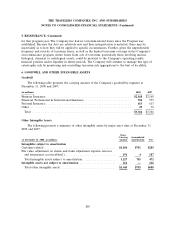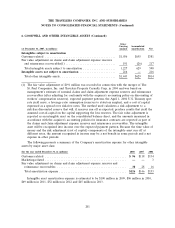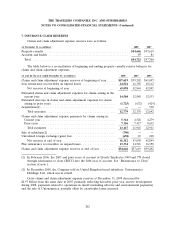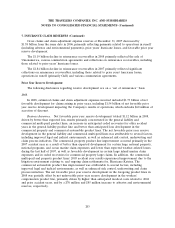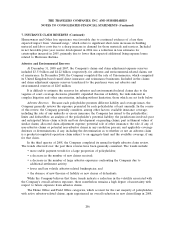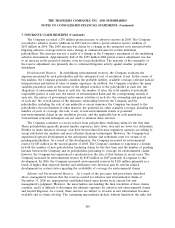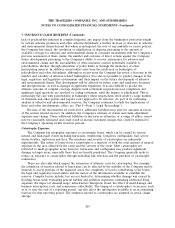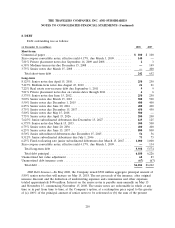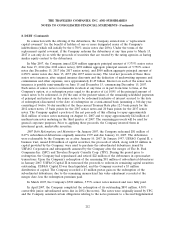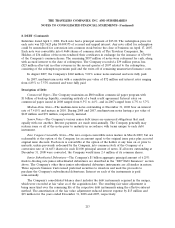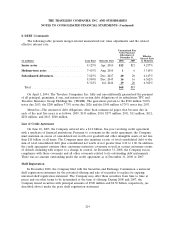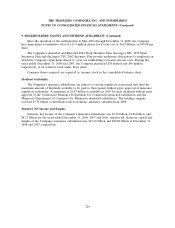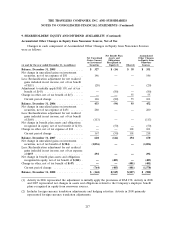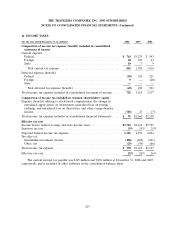Travelers 2008 Annual Report Download - page 221
Download and view the complete annual report
Please find page 221 of the 2008 Travelers annual report below. You can navigate through the pages in the report by either clicking on the pages listed below, or by using the keyword search tool below to find specific information within the annual report.THE TRAVELERS COMPANIES, INC. AND SUBSIDIARIES
NOTES TO CONSOLIDATED FINANCIAL STATEMENTS (Continued)
7. INSURANCE CLAIM RESERVES (Continued)
lack of predictability inherent in complex litigation, any impact from the bankruptcy protection sought
by various asbestos producers and other asbestos defendants, a further increase or decrease in asbestos
and environmental claims beyond that which is anticipated, the role of any umbrella or excess policies
the Company has issued, the resolution or adjudication of disputes pertaining to the amount of
available coverage for asbestos and environmental claims in a manner inconsistent with the Company’s
previous assessment of these claims, the number and outcome of direct actions against the Company,
future developments pertaining to the Company’s ability to recover reinsurance for asbestos and
environmental claims and the unavailability of other insurance sources potentially available to
policyholders, whether through exhaustion of policy limits or through the insolvency of other
participating insurers. In addition, uncertainties arise from the insolvency or bankruptcy of
policyholders and other defendants, although in recent years the Company has noted a decrease in the
number and volatility of asbestos-related bankruptcies. It is also not possible to predict changes in the
legal, regulatory and legislative environment and their impact on the future development of asbestos
and environmental claims. This development will be affected by future court and regulatory decisions
and interpretations, as well as changes in applicable legislation. It is also difficult to predict the
ultimate outcome of complex coverage disputes until settlement negotiations near completion and
significant legal questions are resolved or, failing settlement, until the dispute is adjudicated. This is
particularly the case with policyholders in bankruptcy where negotiations often involve a large number
of claimants and other parties and require court approval to be effective. As part of its continuing
analysis of asbestos and environmental reserves, the Company continues to study the implications of
these and other developments. (Also, see ‘‘Part I—Item 3, Legal Proceedings’’).
Because of the uncertainties set forth above, additional liabilities may arise for amounts in excess
of the current related reserves. In addition, the Company’s estimate of claims and claim adjustment
expenses may change. These additional liabilities or increases in estimates, or a range of either, cannot
now be reasonably estimated and could result in income statement charges that could be material to
the Company’s operating results in future periods.
Catastrophe Exposure
The Company has geographic exposure to catastrophe losses, which can be caused by various
natural and man-made events including hurricanes, windstorms, tornadoes, earthquakes, hail, severe
winter weather, explosions and fires. The incidence and severity of catastrophes are inherently
unpredictable. The extent of losses from a catastrophe is a function of both the total amount of insured
exposure in the area affected by the event and the severity of the event. Most catastrophes are
restricted to small geographic areas; however, hurricanes and earthquakes may produce significant
damage in larger areas, especially those that are heavily populated. The Company generally seeks to
reduce its exposure to catastrophes through individual risk selection and the purchase of catastrophe
reinsurance.
There are also risks which impact the estimation of ultimate costs for catastrophes. For example,
the estimation of reserves related to hurricanes can be affected by the inability of the Company and its
insureds to access portions of the impacted areas, the complexity of factors contributing to the losses,
the legal and regulatory uncertainties and the nature of the information available to establish the
reserves. Complex factors include, but are not limited to: determining whether damage was caused by
flooding versus wind; evaluating general liability and pollution exposures; estimating additional living
expenses; the impact of demand surge; infrastructure disruption; fraud; the effect of mold damage and
business interruption costs; and reinsurance collectibility. The timing of a catastrophe’s occurrence, such
as at or near the end of a reporting period, can also affect the information available to us in estimating
reserves for that reporting period. The estimates related to catastrophes are adjusted as actual claims
emerge.
209



